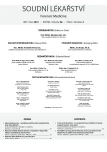LETTER TO EDITOR
Published in the journal:
Soud Lék., 66, 2021, No. 2, p. 27
Category:
dopis editorovi
Dear editor,
we write this letter in response to an article published in Soudní Lékařství last year.
The article entitled: “An autopsy case of heatstroke under the influence of psychotropic drugs” reports the effect of antipsychotics on severe hyperthermia and death (1). The authors collected blood samples at autopsy and toxicological investigation. Their results are summarized in Table 1 (1).
They conclude that the toxic concentration of olanzapine, along with the therapeutic concentration of levomepromazine, may have caused the death of the patient, without any influence of flunitrazepam and nitrazepam (1). We object to such a conclusion, as it defies the modern view on interpretation of postmortem concentrations of drugs in blood (2,3). We assume the blood was collected from the femoral vein.
First, we find inadequate to use (4) as a sole reference for interpretation of postmortem blood concentrations. Schulz and colleagues present intravital data and case reports in their article (4). We would recommend using updated reference values for psychotherapeutics given by Hiemke et al. (5). Notably, these authors introduce the term “laboratory alert level” instead of the toxic range, which we – in accordance with clinical experience – consider more suitable (5). We would also prefer to exploit the findings from articles by Launiainen and Ketola, who give comprehensive data obtained from over 100 000 autopsies (2,3). Using this information, the reader can see, that drugs such as levomepromazine and olanzapine undergo massive postmortem redistribution (PMR), thus shifting the concentrations reported in the present paper to subtoxic ranges.
Second, nitrazepam and flunitrazepam are probably not prone to PMR, same as other benzodiazepines. Therefore, their concentration should be interpreted as toxicologically unneglectable and accordingly should be considered for their sedative properties.
Consequently, we propose another toxicological conclusion to the present case: The patient was likely not intoxicated by olanzapine, but given the detected medication, might have been sedated due to the fast-acting benzodiazepines consumption. The therapy by olanzapine and levomepromazine might have indeed disrupted thermoregulation in the patient and thus might have contributed to the hyperthermia observed in autopsy.
Yours sincerely,
PharmDr. Vít Šesták, Ph.D.*
vit.sestak@fnhk.cz, Institute of Clinical Biochemistry and Diagnostics, University hospital Hradec Králové, Sokolská 581, Hradec Králové, 500 05
RNDr. Martin Mžik, Ph.D.
Institute of Clinical Biochemistry and Diagnostics, University hospital Hradec Králové, Sokolská 581, Hradec Králové, 500 05
Prof. MUDr. Petr Hejna, Ph.D., MBA
Department of Forensic Medicine, University hospital Hradec Králové, Sokolská 581, Hradec Králové, 500 05
Zdroje
- Kinoshita H, Tanaka N, Kumihashi M, et al. An autopsy case of heatstroke under the influence of psychotropic drugs Soud Lek 2020; 65(4): 76-78.
- Launiainen T, Ojanperä I. Drug concentrations in post-mortem femoral blood compared with therapeutic concentrations in plasma. Drug Test Anal 2014; 6(4): 308-316.
- Ketola R, Ojanperä I. Summary statistics for drug concentrations in post‐mortem femoral blood representing all causes of death. Drug Test Anal 2019; 11(9): 1-12.
- Schulz M, Iwersen-Bergmann S, Andersen H, et al. Therapeutic and toxic blood concentration of nearly 1 000 drugs and other xenobiotics. Crit Care 2012; 16: R136.
- Hiemke C, Bergemann N, Clement HW, et al. Consensus guidelines for therapeutic drug monitoring in Neuropsychopharmacology: Update 2017. Pharmacopsychiatry 2018; 51(1-02): 9-62.
Štítky
Patologie Soudní lékařství ToxikologieČlánek vyšel v časopise
Soudní lékařství

2021 Číslo 2
Nejčtenější v tomto čísle
- Akutní disekce aorty – neočekávaná příčina úmrtí mladé těhotné ženy. Popis případu.
- Za primářem MUDr. Otto Boubelíkem
- Přepočty obj% alkoholu na g v 0,5 litru piva.
- Dopis editorovi
